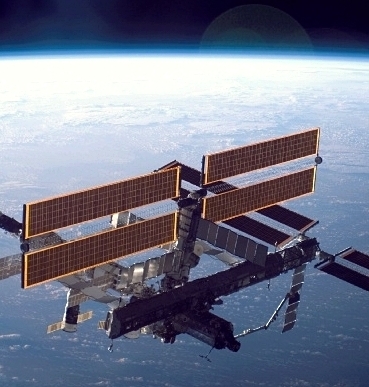
 Construction Work Resumed At the International Space Station (ISS). This is how the International Space Station is looking like, in September 2006, after that the Space Shuttle mission STS-115 resumed the construction work at the orbital outpost. The International Space Station began in November 1998 as a 16-nation partnership. It was gradually constructed through a mix of Space Shuttle flights and Russian Progress cargo-craft and Proton rockets. A lull in the construction occurred between February 2003 and September 2006 due to the loss of the Shuttle Columbia. With the STS-115 mission flight, the Space Shuttle crewmembers brought to the Station a new truss, along with its solar arrays, which have doubled the power available. The new truss and the solar arrays are seen left, on the picture, left of the frontal, dark bar at the front of the ISS. The ISS is seen on the background of the Earth. The ISS program has now been included into the new U.S. "Vision for Space Exploration", which is setting the next steps for the U.S. spatial development, as it will mainly serve like an orbital laboratory for assessment of the questions related to the long-duration space journeys. The results will surely be useful for the journeys to Mars. picture NASA
Construction Work Resumed At the International Space Station (ISS). This is how the International Space Station is looking like, in September 2006, after that the Space Shuttle mission STS-115 resumed the construction work at the orbital outpost. The International Space Station began in November 1998 as a 16-nation partnership. It was gradually constructed through a mix of Space Shuttle flights and Russian Progress cargo-craft and Proton rockets. A lull in the construction occurred between February 2003 and September 2006 due to the loss of the Shuttle Columbia. With the STS-115 mission flight, the Space Shuttle crewmembers brought to the Station a new truss, along with its solar arrays, which have doubled the power available. The new truss and the solar arrays are seen left, on the picture, left of the frontal, dark bar at the front of the ISS. The ISS is seen on the background of the Earth. The ISS program has now been included into the new U.S. "Vision for Space Exploration", which is setting the next steps for the U.S. spatial development, as it will mainly serve like an orbital laboratory for assessment of the questions related to the long-duration space journeys. The results will surely be useful for the journeys to Mars. picture NASA
 La construction de la Station Spatiale Internationale a repris
La construction de la Station Spatiale Internationale a repris
Les travaux de construction ont repris à la Station Spatiale Internationale. Voilà à quoi ressemble la station orbitale en septembre 2006, après que la mission STS-115 de la navette spatiale s'y soit déroulée. La Station Spatiale Internationale -l'"ISS"- a fait ses débuts en novembre 1998. Elle était alors un parteneriat entre 16 pays. Elle fut progressivement construite par le biais de missions de la navette américaine et de vaisseaux-cargo Progess et de fusées Proton russes. La construction a été interrompue de février 2003 à septembre 2006 du fait de la perte de la navette Colombia lors de son retour sur Terre. Les travaux reprennent donc avec la mission STS-115. La mission apportait à la Station une nouvelle poutre et ses panneaux solaires, lesquels vont permettre de doubler l'énergie disponible. Le nouvel ensemble est vu sur la gauche de l'image, à gauche de la barre (sombre) qui forme l'avant de l'ISS. Le fond de l'image est constitué par la Terre. La Station Spatiale Internationale a maintenant été incluse dans la nouvelle conception du programme spatial américain, la "Vision for Space Exploration" -qui vise le retour sur la Lune et Mars- et la Station va essentiellement servir de laboratoire spatial où seront testées les questions des vols de longue durée dans l'espace. Les résultats seront utiles pour les vols vers Mars. NASA
Website Manager: G. Guichard, site 'Amateur Astronomy,' http://stars5.6te.net. Page Editor: G. Guichard. last edited: 12/28/2010. contact us at ggwebsites@outlook.com


![]() La construction de la Station Spatiale Internationale a repris
La construction de la Station Spatiale Internationale a repris